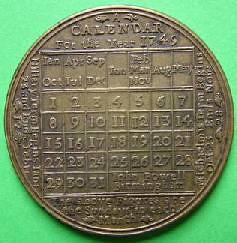
PREV ARTICLE
FULL ISSUE
PREV FULL ISSUE
FEATURED WEB PAGE: CALENDAR MEDALSThis week's Featured Web page is the Token Corresponding Society's page on Calendar Medals.

Calendar medals first appeared, in several countries of mainland Europe, during the 17th century. At their simplest, they told you the day of the week on which the Sundays occurred, or perhaps when the first of each month occurred, plus the number of days in those months. Many of them were much more elaborate, attempting to list a variety of astronomical phenomena, of which the lunar phases and sunset times rank amongst the more obvious. The amount of data to be accommodated is considerable, in consequence of which the lettering is often very small and the pieces themselves decidedly large; 42-44 mm diameter is not uncommon, and anything up to 60mm possible. Most are in the range 37-44mm. Most early pieces made use of the fact that, since there are seven days in the week and a leap year every four years, the pattern of days on which Sunday falls repeats every 28 years; thus, if you knew where in the cycle the current year was, and that was all you wanted to know, one piece would suffice for a long time. Others made lists of years for as many years as could be fitted on the piece. There were many experiments as to how to make the best use of the space available, and considerable variety of design in consequence. www.tokensociety.org.uk/topics/calendar.shtmlWayne Homren, Editor The Numismatic Bibliomania Society is a non-profit organization promoting numismatic literature. See our web site at coinbooks.org. To submit items for publication in The E-Sylum, write to the Editor at this address: whomren@gmail.com To subscribe go to: https://my.binhost.com/lists/listinfo/esylum All Rights Reserved. NBS Home Page Contact the NBS webmaster 
|